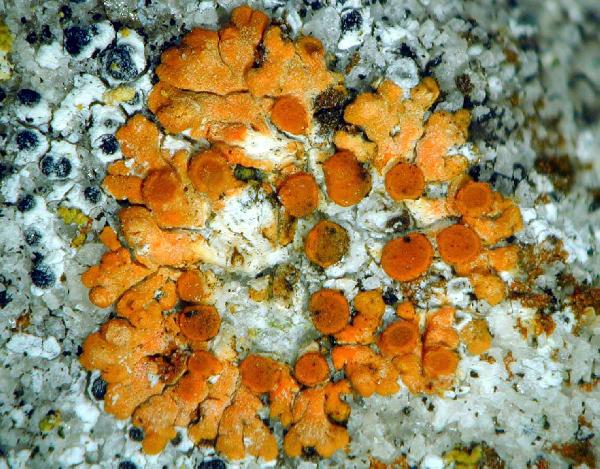Calogaya saxicola (Hoffm.) Vondrák
in Vondrák & al., Lichenologist 48: 178, 2016.. Basionym: Psora saxicola Hoffm. - Descr. Adumb. Plant. Lich. 1, 3: 82, 1790.
Synonyms:
Distribution: N - Frl (TSB 21344), Piem (TSB 33202). .
Description: Thallus crustose-placodioid, episubstratic, forming orbicular, up to 8 mm wide rosettes, ochraceous yellow to orange, epruinose. Central part of thallus with convex, 0.3-0.6 mm wide areoles which are rarely visible, the thallus center being covered by crowded apothecia; marginal lobes highly reduced, sometimes hardly visible, strongly convex, 0.3-0.8(-1) mm long and (0.1-)0.2-0.8(-1) mm wide. Upper cortex well developed, (15-)20-80 μm thick, with a 5-30 μm thick orange upper layer, and a hyaline lower layer with irregularly arranged hyphae. Apothecia lecanorine to zeorine, sometimes pseudolecanorine, abundant, 0.2-2.5(-4) mm diam., usually deformed by mutual compression, forming clusters on the lobe bases and areoles, at first immersed, then sessile and basally constricted, with a concave to convex, orange to reddish-orange, epruinose, smooth disc and a margin which in some cases is clearly differentiated in an orange, 30- 50 μm thick proper margin and a 40-150(-200) μm thick, usually persistent and often prominent thalline margin. Epithecium (6.5-)10-14 μm thick, brownish-yellow, K+ purple-red; hymenium colourless, 50-30(-92) μm high; paraphyses septate, sparingly branched in upper part, (1.5-)2-3(-4.5) μm wide at base, the apical cells (2.5-)3- 7.7(-8.5) μm wide; hypothecium colourless. Asci 8-spored, clavate, functionally unitunicate, apically thickened with a broad internal beak, the inner part of apex and external cap I+ blue, Teloschistes-type. Ascospores 1-septate, polarilocular, hyaline, narrowly ellipsoid, (9-)11-14.5(-18.5) x (4-)5.8-6.5(-7.5) μm, the equatorial thickening ("septum") (1.5-)3.4-4.5(-5) μm. Photobiont chlorococcoid. Spot tests: thallus and apothecia K+ purple-red, C-, KC-, P-. Chemistry: thallus and apothecia with parietin (major), fallacinal, emodin, teloschistin and parietinic acid (minor), corresponding with chemosyndrome A of Søchting (1997).Note: a very poorly understood species (see Gaya 2009), purportedly growing on both calcareous and siliceous rocks. The greatest majority of Italian samples filed under this name proved to belong to C. pusilla, except a few critical samples, which however could also belong to other species, so that the occurrence of this species in Italy is dubious.
Growth form: Crustose placodiomorph
Substrata: rocks
Photobiont: green algae other than Trentepohlia
Reproductive strategy: mainly sexual
Poorly known taxon in need of further study
Commonnes-rarity: (info)
Alpine belt: very rare
Subalpine belt: very rare
Oromediterranean belt: very rare
Montane belt: rare
Submediterranean belt: very rare
Padanian area: absent
Humid submediterranean belt: very rare
Humid mediterranean belt: absent
Dry mediterranean belt: absent

Predictive model
Herbarium samples


Curtis Randall Björk – CC BY-SA 4.0
British Columbia, Thompson Plateau, Kamloops area, Mt. Mara On calc-modified siliceous cliff in grassland 2012-11-01

Jacques Haine - Source: http://www.lichensmaritimes.org/index.php?task=fiche&lichen=268&lang=en
Belgium, Floreffe

Jacques Haine - Source: http://www.lichensmaritimes.org/index.php?task=fiche&lichen=268&lang=en
Belgium, Floreffe

Jacques Haine - Source: http://www.lichensmaritimes.org/index.php?task=fiche&lichen=268&lang=en
Belgium, Floreffe

Jacques Haine - Source: http://www.lichensmaritimes.org/index.php?task=fiche&lichen=268&lang=en
Belgium, Floreffe
Growth form: Crustose placodiomorph
Substrata: rocks
Photobiont: green algae other than Trentepohlia
Reproductive strategy: mainly sexual
Poorly known taxon in need of further study
Commonnes-rarity: (info)
Alpine belt: very rare
Subalpine belt: very rare
Oromediterranean belt: very rare
Montane belt: rare
Submediterranean belt: very rare
Padanian area: absent
Humid submediterranean belt: very rare
Humid mediterranean belt: absent
Dry mediterranean belt: absent

Predictive model
| Herbarium samples |


Curtis Randall Björk – CC BY-SA 4.0
British Columbia, Thompson Plateau, Kamloops area, Mt. Mara On calc-modified siliceous cliff in grassland 2012-11-01

Jacques Haine - Source: http://www.lichensmaritimes.org/index.php?task=fiche&lichen=268&lang=en
Belgium, Floreffe

Jacques Haine - Source: http://www.lichensmaritimes.org/index.php?task=fiche&lichen=268&lang=en
Belgium, Floreffe

Jacques Haine - Source: http://www.lichensmaritimes.org/index.php?task=fiche&lichen=268&lang=en
Belgium, Floreffe

 INDEX FUNGORUM
INDEX FUNGORUM
 GBIF
GBIF
 DOLICHENS
DOLICHENS



